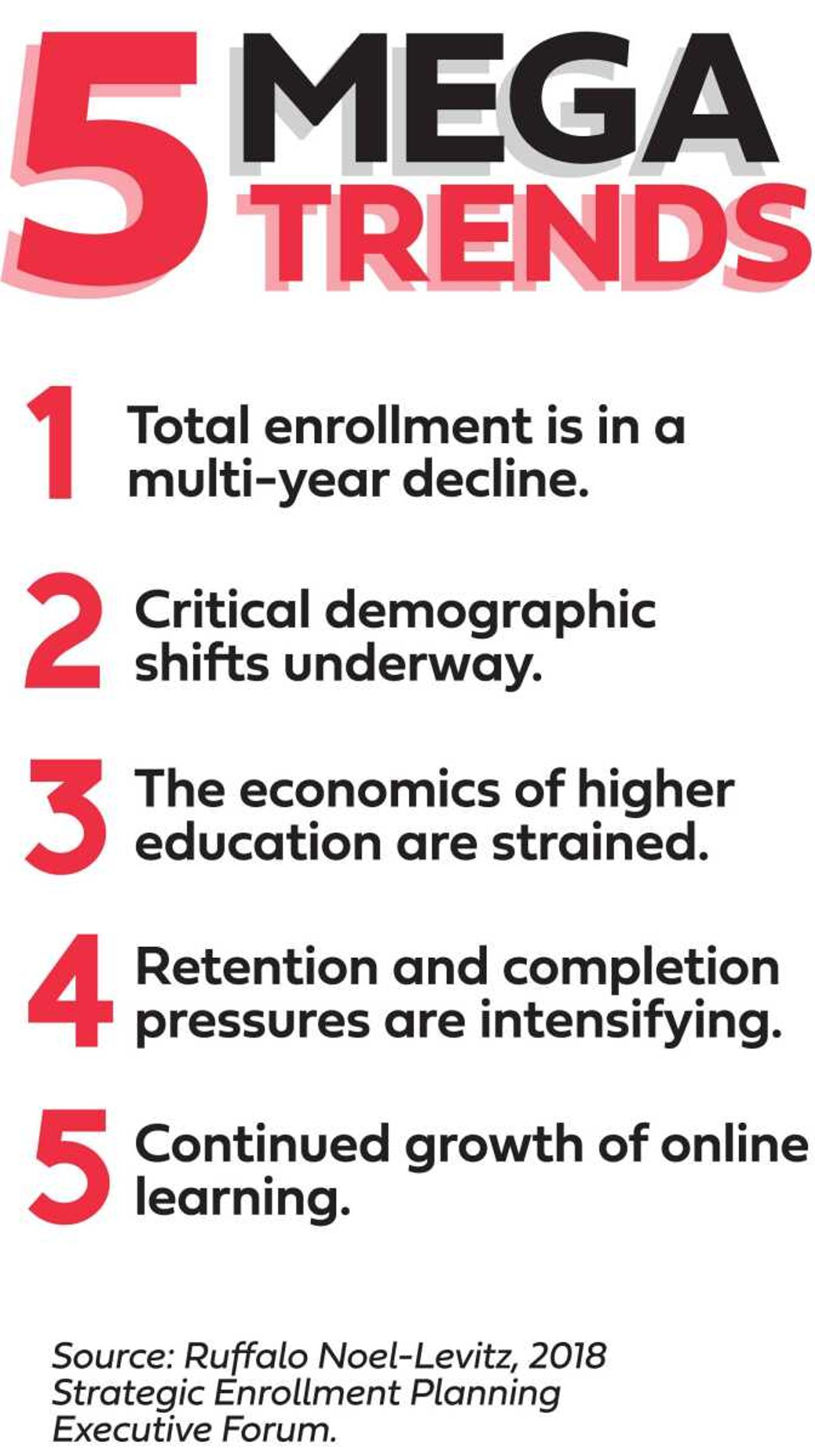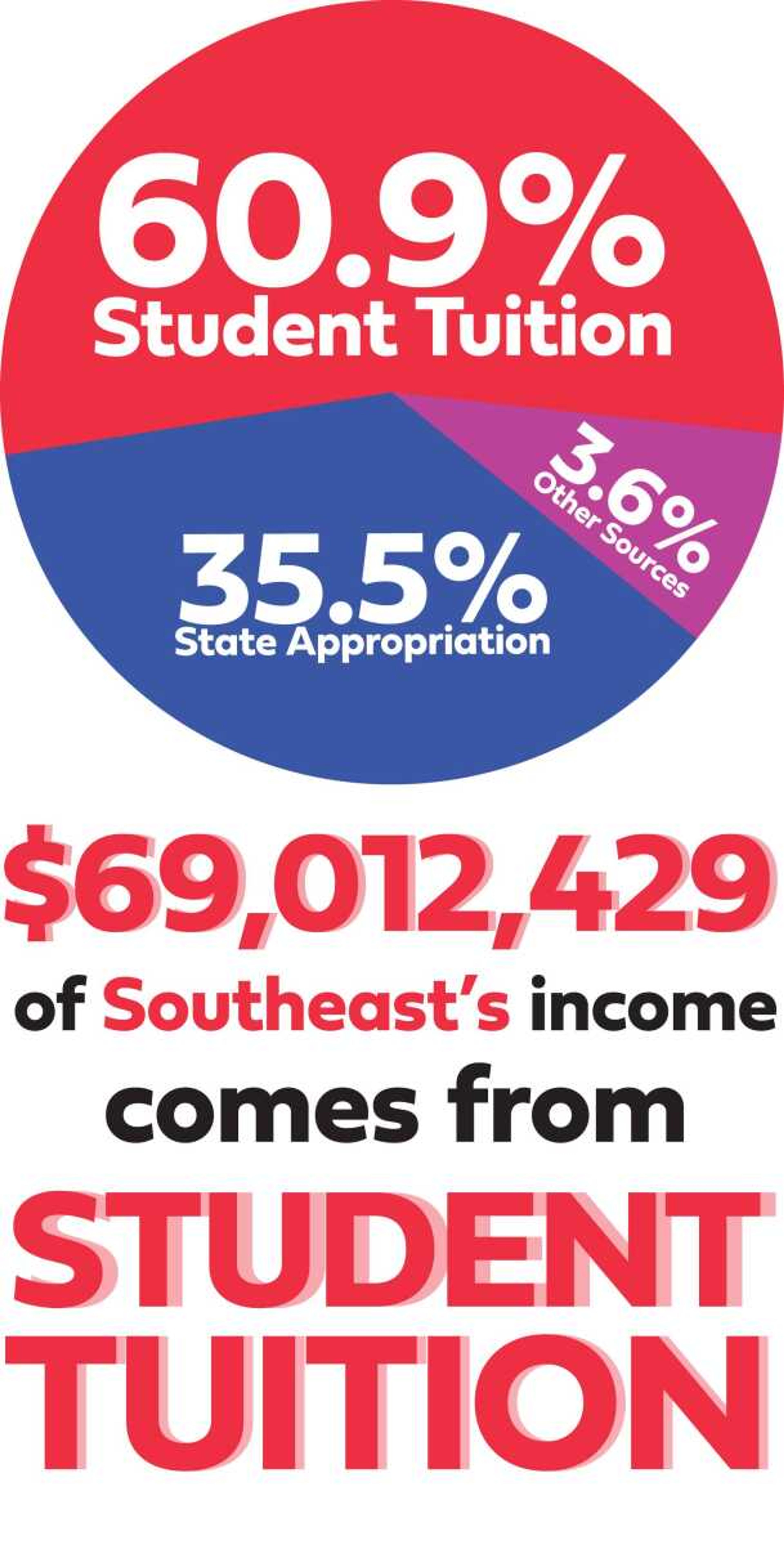Southeast’s enrollment suffers after 18 years of growth
For the last four years, Southeast Missouri State has experienced a decline in its number of students. It comes on the heels of 20 consecutive years of increased enrollment. There are a few things that have led to the decline in enrollment including lower birth rates, fewer high school graduates, and even a decline in community college enrollment, said Deborah Below, vice president for enrollment management and student success...
For the last four years, Southeast Missouri State has experienced a decline in its number of students. It comes on the heels of 20 consecutive years of increased enrollment.
There are a few things that have led to the decline in enrollment including lower birth rates, fewer high school graduates, and even a decline in community college enrollment, said Deborah Below, vice president for enrollment management and student success.
Below noted a little more than half of the university’s revenue comes in the form of tuition, amounting to $69,012,429 out of the $113,281,247 total estimated income for FY19.
This is important because when the university's primary revenue source drops, it's more difficult to recover the funding elsewhere in the budget.
“The quick answer is there are fewer students enrolling in college, but it’s much more complex than that,” Below said.
Southeast has a strategic enrollment management planning process, which Below leads. She recently had the opportunity to visit and discuss the process with many faculty and student groups on campus. The planning process is trying to thematically develop tactics related to prioritizing Southeast’s academic programs and expanding and enhancing the way the university delivers its programs.

One thing Below has shared with those groups is the five “megatrends” as to why enrollments are declining. These consist of total enrollment in a multi-year decline, critical demographic shifts, the fact that the economics of higher education are strained, retention and completion pressures are intensifying and continued growth of online learning — which Below said “fortunately at Southeast that has grown more than the state average, over multiple years.”

Below explained how after World War II, higher education enrollments in the United States have only dipped three times. The first decline was in the late 1940s, while the second decline — in the ’90s — actually mirrored Southeast’s enrollment, Below said.
The decline stopped around 1994, she added. In 1995 Southeast had a headcount of 8,118, beginning its 20 years of increased enrollment, which peaked at 12,087 in 2014.
“We had 20 years of consecutive enrollment growth at Southeast until 2014,” Below said. “Those were very good times for the university.”
The incoming freshman numbers decreased by 230 in Fall 2018 from the previous year’s census, according to the Office of Institutional Research.
When looking at enrollment, Below looks at the fall semester census after the fourth week of class, noting it’s the easiest and most consistent way to do so.
According to data from the Western Interstate Commission for Higher Education, “Knocking at the College Door,” there are fewer high school graduates in the United States, which is another contributing factor to the enrollment decline as a whole and at Southeast, Below said.
“There are fewer high school graduates because there are fewer people of that generation, period,” she said. “So the birth rate has declined and is anticipated to decline for some time. So what we’re experiencing in the world of enrollment management and university administration in general is that universities are rethinking who, how, when and where they offer their educational programs.”
Below and vice president for finance and administration Kathy Mangels had the opportunity to attend the Ruffalo Noel Levitz 2018 Strategic Enrollment Planning Executive Forum Conference in Las Vegas, where they were given some insight on the country’s enrollment goals as a whole.
Below said they were told 70% of institutions in the U.S. want to grow, but based on enrollment trends, no more than 40% will actually be able to.
“And they were trying to tell us and warn us, ‘There’s a bit of a mismatch between your aspirations and what’s possible,’” Below said.
Community college enrollment being down also hurts Southeast’s enrollment, Below said. Using data provided by the Missouri Department of Higher Education, Below explained the correlation.
“[Community colleges] are down 18.7% over five years,” she said. “But those that feed Southeast have declined 24%. That’s impacting us. Our closest community college partner would be Three Rivers and, if you look, they’ve declined 30% in five years.”
According to the Missouri Department of Higher Education, the top six community colleges in Southeast Missouri that serve as feeder schools for Southeast have lost 24.3% in their total headcount since 2013. Below said when community colleges experience enrollment declines there’s a smaller pool of transfer students to attract to Southeast.
Along with the megatrends, Below touched on what she called mega-universities, or “Amazon’s in education” becoming more and more popular among online students. Schools such as the University of Phoenix are becoming as large as 100,000 students, Below said, which can be a challenge for Southeast.
“It's always a balancing act to make sure we're meeting the needs of both our online learners and our face-to-face learners,” she said.
As recent as August 2017, Southeast’s online enrollment was nearly 1,300, according to a story in the Southeast Missourian.
Below said the number of Missouri’s high school graduates should grow by 2% by 2023. She said a challenge is that 1,000 of Southeast’s current enrollment of 11,071 students come from Illinois, and Illinois’ number of high school graduates is declining, according to Western Interstate Commission for Higher Education.
Below said another issue regarding declining enrollment is its impact on diversity.
While the number of Missouri’s high school graduates is expected to grow, the number of white students at Southeast is anticipated to decrease.
“We’re actually going to decline by nearly 2% in white students,” she said, adding that roughly 80% of Southeast’s headcount is white. About 8% of the headcount consists of black students, 2% is Hispanic and 1% is Asian, according to the Office of Institutional Research.
Below said Southeast needs to not just focus on its recruitment efforts in order to fix this issue — going to high schools with African-American and Hispanic students is not enough to ensure increased diversity while also providing a high-quality academic experience.
“They have to find mentors like them,” Below said. “But if you come here and you don't see somebody who looks like you, or hasn't been through the same thing, or they're hard to find, you may not stay.”
Another issue Below presented was where alumni live after graduation. She pointed out that a lot of Southeast alumni end up in Texas or Kansas City after graduation, but if graduates go to St. Louis, they’re more likely to send their children to Southeast when the time comes, she said.
Below said there can sometimes be competition among universities in the area that can cause a stall in enrollment.
In 2015 the university adopted the “Will to Do” branding statement to help unify its messaging, and in 2016 and 2017 Southeast saw a record number of beginning freshmen enrolling, Below said.
“Other schools pay attention,” she said. “And at the same time, Mizzou had been losing students, both first-year students and overall headcount in their enrollment. So just like we went through a branding effort, they and other institutions followed and went through branding efforts. And I'm not saying that they're following us, but those happened after ours.”
Below said this had an impact on Southeast’s headcount.
“And so consequently, we and many other Missouri institutions and Illinois institutions right now are going through strategic enrollment planning processes,” she said.
Below said while enrollment can have an impact on faculty morale, she believes the university will become stronger because of what it’s faced.
“I just choose to continue to be remained very focused on that piece,” she said. “I'm very positive about where the university is headed.”




